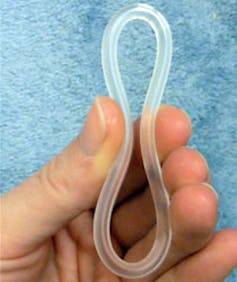The development of the pill was a game changer for birth control in the 1960s. It was enthusiastically embraced by women who were desperate for some control over their fertility, despite the side effects associated with high doses of estrogen.
Condoms were promoted for HIV prevention in the 1990s but have been used in various forms for hundreds of years. Condoms remain the only simultaneous protection against sexually transmitted infections and unintended pregnancy.
But what else has come onto the market since then?
Today there are five general categories of options for birth control:
pills that need to be taken every day,
non-daily “set and forget” methods,
barrier methods used each time you have sex, such as condoms and diaphragms,
permanent methods (such as vasectomy for men or tubal ligation for women) where the tubes delivering the egg or sperm are cut,
“natural” methods such as the withdrawal method (the man “pulling out” before ejaculation) or avoiding sex (abstinence) all together or at fertile times in the woman’s cycle.
The pill is the most popular form of contraception in Australia. But in terms of efficacy and side effects, it’s rivalled by “set and forget” methods. Let’s look at both categories.
Pills
“The pill” or combined pill contains both estrogen and progestogen and must be taken every day. It mimics pregnancy hormones and stops the release of an egg from the woman’s ovaries.
More than 30 different types of pills are available in Australia, with some prescribed to treat acne, regulate periods, alleviate menstrual pain. Around half are listed on the Pharmaceutical Benefits Scheme, so government subsidies make them affordable for most women.

The potential side effects vary from mild feelings of discomfort to life threatening blood clots, so they must be prescribed appropriately.
If taken as instructed, the pill is very effective in preventing pregnancy (99.7%, so less than one woman out of 100 would become pregnant over one year of use). But allowing for missed pills the effectiveness decreases to 91%.
The progestogen-only “mini” pill is a better option for women who have side effects related to estrogen. The main disadvantage is that it must be taken at the same time each day, which may be a problem for women without a regular routine.
Non-daily “set and forget” methods
There are a variety of non-daily methods, most of which are more effective, in practice, than pills because they don’t depend on daily use. Many use the same hormones as pills which means that there will be similar potential side effects.
Depo, a progestogen injection, lasts for three months but it may take some time for fertility to return once the injections are stopped.

Implants such as Implanon (a soft rod inserted under the skin of the upper arm) last for three years and are more than 99.5% effective, but may cause unpredictable bleeding patterns that can be annoying.
The vaginal ring, (NuvaRing) is a small flexible ring containing estrogen and progestogen that sits inside the vagina for three weeks. After three weeks the ring is removed for a week to allow for a period, and then a new one is inserted. The vaginal ring has similar effectiveness and side effects as the combined pill but has the advantage that it doesn’t have to be taken every day.
Intra-uterine devices (IUDs) are small devices placed in the uterus to stop pregnancy and are more than 99% effective. There is a hormonal IUD (Mirena) which lasts for five years, and a copper IUD that lasts for ten years.

The beauty of long-acting reversible contraceptives such as the implant or IUD is that they are not dependent on memory or skill.
Never heard of some of these? You’re not alone. General practitioners can be reluctant to discuss long-active contraceptive options. Unless a doctor has a particular interest in contraception he or she may not be fully aware of all the non-daily contraceptive options, particularly the newer methods or those that require special training.
GPs are also under pressure to minimise consultation time. It’s not hard to see why it would be easier to write a prescription for a pill than to start a conversation about other options.
What’s right for you?
Everyone has different contraceptive needs and it can sometimes take a while to figure out what’s right for you. There is no ideal contraceptive method, and there’s not likely to be one in the near future.
For now, the best option is to treat contraception as you would any consumer product – research the options thoroughly, decide what types might be best for you and then seek advice from well qualified providers you trust who specialise in the area. You can also consult online tools, factsheets and help lines.
Contraceptive methods vary in their effectiveness to prevent pregnancy. The theoretical effectiveness of most methods is very high. But the actual effectiveness is lower if they can be forgotten (like a pill), break (like a condom), or “misfire” (like the withdrawal method).
Remember that it’s not just medical suitability that determines which contraceptive option is best for you and your partner. Contraceptive needs change over the reproductive life cycle, depending on whether you are having sex regularly, how much you want to avoid pregnancy, and whether you want to have children in the future.

